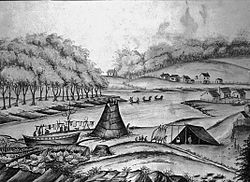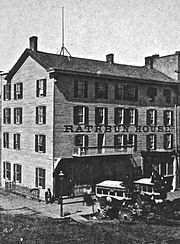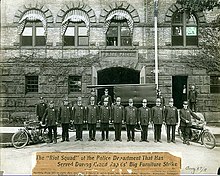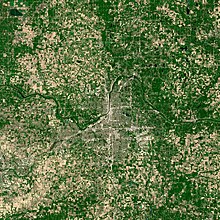
A | B | C | D | E | F | G | H | CH | I | J | K | L | M | N | O | P | Q | R | S | T | U | V | W | X | Y | Z | 0 | 1 | 2 | 3 | 4 | 5 | 6 | 7 | 8 | 9
Grand Rapids | |
|---|---|
| Nicknames: GR, River City, Beer City, Furniture City | |
| Motto(s): | |
 Interactive map of Grand Rapids | |
| Coordinates: 42°57′40″N 85°39′20″W / 42.96111°N 85.65556°W | |
| Country | |
| State | |
| County | Kent |
| Founded | 1826 |
| Incorporated | 1838 (village) 1850 (city) |
| Government | |
| • Type | City commission |
| • Mayor | Rosalynn Bliss (D) |
| • Manager | Mark Washington |
| • Clerk | Joel Hondorp (R) |
| Area | |
| • City | 45.63 sq mi (118.19 km2) |
| • Land | 44.78 sq mi (115.97 km2) |
| • Water | 0.86 sq mi (2.22 km2) 1.92% |
| Elevation | 640 ft (200 m) |
| Population (2020) | |
| • City | 198,893 |
| • Rank | US: 115th MI: 2nd |
| • Density | 4,442.49/sq mi (1,715.26/km2) |
| • Urban | 605,666 (US: 70th) |
| • Urban density | 2,207.6/sq mi (852.3/km2) |
| • Metro | 1,077,370[2] (US: 52nd) |
| • CSA | 1,412,470[2] (US: 42nd) |
| Demonym | Grand Rapidian |
| Time zone | UTC−5 (EST) |
| • Summer (DST) | UTC−4 (EDT) |
| ZIP Codes | 49501–49508, 49510, 49514–49516, 49518, 49523, 49525, 49534, 49546, 49548, 49555, 49560, 49588, 49594 |
| Area code | 616 |
| FIPS code | 26-34000 |
| GNIS feature ID | 0627105[3] |
| Website | GrandRapidsMI.gov |
Grand Rapids is a city in and county seat of Kent County, Michigan, United States.[4] At the 2020 census, the city had a population of 198,893,[5] making it the second-most populous city in Michigan, after Detroit. Grand Rapids is the central city of the Grand Rapids metropolitan area, which has a population of 1,087,592 and a combined statistical area population of 1,383,918.[2]
Located 161 miles (259 km) northwest of Detroit, Grand Rapids is situated along the Grand River approximately 25 miles (40 km) east of Lake Michigan, it is the economic and cultural hub of West Michigan. A historic furniture manufacturing center, Grand Rapids is home to five of the world's leading office furniture companies and is nicknamed "Furniture City". Other nicknames include "River City". The city and surrounding communities are economically diverse, based in the health care, information technology, automotive, aviation, and consumer goods manufacturing industries, among others.
Grand Rapids was the childhood home of U.S. President Gerald Ford, who is buried with his wife Betty on the grounds of the Gerald R. Ford Presidential Museum in the city.[6] The city's Gerald R. Ford International Airport and Gerald R. Ford Freeway are named after him.
History
Nineteenth century: Native American and European-American settlement
Trading post
After the French established territories in Michigan, Jesuit missionaries and traders traveled down Lake Michigan and its tributaries.[7]
In 1806, white trader Joseph La Framboise and his Métis wife, Madeline La Framboise, traveled by canoe from Mackinac Island and established the first trading post in West Michigan in present-day Grand Rapids on the banks of the Grand River, near what is now Ada Township, the junction of the Grand and Thornapple Rivers. They were French-speaking and Roman Catholic. They likely both spoke Odawa, Magdelaine's maternal ancestral language. In the fall of 1806, Joseph was fatally stabbed by a member of the Potawatomi tribe named Nequat. Joseph had been with his family and an entourage of voyageurs traveling between Grand River and Grand Rapids. The Potawatomi man had insisted that Joseph trade liquor with him. When Joseph refused, the man left, only to return at dusk when Joseph, who faithfully performed the ritual of Angelus every day at that time, was in prayer. Nequat stabbed the trader, fatally wounding him, leaving Joseph's wife, Magdelaine, a widow at age twenty-four.[8]
The next spring, a delegation from the Potawatomi tribe brought the offender, Nequat, before Magdelaine for her sentence upon him for the death of her husband. It was their tradition for the victim's family to avenge deaths within that tribe. Magdelaine refused to sentence him and, in an act of forgiveness, told the Potawatomi tribe members to let him go and that God would be his judge. Though Magdelaine had forgiven Nequat, the tribe had not. Nequat's body was found stabbed with his own knife the next season.[8]
After the murder of her husband in 1806 while en route to Grand Rapids, Magdelaine La Framboise carried on the trade business, expanding fur trading posts to the west and north, creating a good reputation among the American Fur Company. La Framboise, whose mother was Odawa and father French, later merged her successful operations with the American Fur Company.[7]
Native American settlement
By 1810, Chief Noonday,or Nowaquakezick, an Odawa chief, established the village of Bock-a-tinck (from Baawiting, "at the rapids") on the northwest side of present-day Grand Rapids near Bridge Street with about 500 Odawa, though the population would grow to over 1,000 on occasion.[9][10] During the War of 1812, Noonday was allied with Tecumseh during the Battle of the Thames. Tecumseh was killed in this battle, and Noonday inherited his tomahawk and hat.[11] A second village existed lower down the river with its center located at the intersection of what is now Watson Street and National Avenue, with Chief Black Skin – known by his native name recorded as Muck-i-ta-oska or Mukatasha (from Makadewazhe or Mkadewzhe, "Have Black Skin") and was son of Chief Noonday – leading the village.[10]
European settlement
In 1820, General Lewis Cass, who was on his way to negotiate the first Treaty of Chicago with a group of 42 men, commissioned Charles Christopher Trowbridge to establish missions for Native Americans in the Grand River Valley, in hopes of evangelizing them.[12][10] In 1821, the Council of Three Fires signed the first Treaty of Chicago, ceding to the United States all lands in Michigan Territory south of the Grand River, except for several small reservations, and required a native to prepare land in the area to establish a mission.[10][13] The treaty also included "One hundred thousand dollars to satisfy sundry individuals, in behalf of whom reservations were asked, which the Commissioners refused to grant" of which Joseph La Framboise received 1,000 dollars immediately and 200 dollars a year, for life.[13] Madeline La Framboise retired the trading post to Rix Robinson in 1821 and returned to Mackinac.[7] That year, Grand Rapids was described as being the home of an Odawa village of about 50 to 60 huts on the north side of the river near the 5th Ward, with Kewkishkam being the village chief and Chief Noonday being the chief of the Odawa.[12]
The first permanent European-American settler in the Grand Rapids area was Isaac McCoy, a Baptist minister.[12] In 1823, McCoy, Paget, a Frenchman who brought along a Native American pupil, and a government worker traveled to Grand Rapids from Carey Mission near present-day Niles, Michigan to arrange a mission they called the "Thomas Mission", though negotiations fell through with the group returning to the Carey Mission for the Potawatomi on the St. Joseph River.[12][10] The government worker stayed into 1824 to establish a blacksmith shop, though the shop was burned down by the Odawa.[10] Later in May 1824, Baptist missionary Reverend Leonard Slater traveled with two settlers to Grand Rapids to perform missionary work, though the group began to return to the Carey Mission after only three days due to threats.[12][10] While the group was returning, they encountered Chief Noonday who asked for the group to stay and establish a mission, believing that the Odawa adapting to European customs was the only chance for them to stay in the area.[10] The winter of 1824 was difficult, with Slater's group having to resupply and return before the spring.[10][12] Chief Noonday, deciding to be an example for the Odawa, chose to be baptized by Slater in the Grand River, though some of his followers believed that this was a wrestling match between the two that Slater won.[10] Slater then erected the first settler structures in Grand Rapids, a log cabin for himself and a log schoolhouse.[12] In 1825, McCoy returned and established a missionary station.[14] He represented the settlers who began arriving from Ohio, New York and New England, the Yankee states of the Northern Tier.

Shortly after, Detroit-born Louis Campau, known as the official founder of Grand Rapids, was convinced by fur trader William Brewster, who was in a rivalry with the American Fur Company, to travel to Grand Rapids and establish trade there.[12] In 1826, Campau built his cabin, trading post, and blacksmith shop on the south bank of the Grand River near the rapids, stating the Native Americans in the area were "friendly and peaceable".[12] Campau returned to Detroit, then returned a year later with his wife and $5,000 of trade goods to trade with the Odawa and Ojibwa, with the only currency being fur.[12] Campau's younger brother Touissant would often assist him with trade and other tasks at hand.[12]
Lucius Lyon, a Yankee Protestant who would later become a rival to Campau, was contracted by the federal government to survey the Grand River Valley in the fall of 1830 and in the first quarter of 1831. The federal survey of the Northwest Territory reached the Grand River, with Lyon using a surveyor's compass and chain to set the boundaries for Kent County, named after prominent New York jurist James Kent.[12][10] In 1833, a land office was established in White Pigeon, Michigan, with Campau and fellow settler Luther Lincoln seeking land in the Grand River valley.[12] Lincoln purchased land in what is now known as Grandville, while Campau became perhaps the most important settler when he bought 72 acres (291,000 m2) from the federal government for $90 and named his tract Grand Rapids. Over time, it developed as today's main downtown business district.[15] In the spring of 1833, Campau sold to Joel Guild, who traveled from New York, a plot of land for $25.00, with Guild building the first frame structure in Grand Rapids, which is now where McKay Tower stands.[12][16] Guild later became the postmaster, with mail at the time being delivered monthly from the Gull Lake, Michigan to Grand Rapids.[12] Grand Rapids in 1833 was only a few acres of land cleared on each side of the Grand River, with oak trees planted in light, sandy soil standing between what is now Lyon Street and Fulton Street.[12]

By 1834, the settlement had become more organized. Rev. Turner had established a school on the east side of the river, with children on the west side of the river being brought to school every morning by a Native American on a canoe who would shuttle them across the river. Multiple events happened at Guild's frame structure, including the first marriage in the city, one that involved his daughter Harriet Guild and Barney Burton, as well as the first town meeting that had nine voters. It was also this year Campau began constructing his own frame building—the largest at the time—near present-day Rosa Parks Circle.[12]
In 1835, many settlers arrived in the area with the population growing to about 50 people, including its first doctor, Dr. Wilson, who was supplied with equipment from Campau.[12] Lucius Lyon, using his knowledge from surveying the area, returned to Grand Rapids to purchase the rest of the prime land and called his plot the Village of Kent.[12][10] When Lyon and his partner N. O. Sergeant returned after their purchase, they arrived along with a posse of men carrying shovels and picks, intending to build a mill race. The group arrived to the music of a bugle which startled the settlement, with Chief Noonday offering Campau assistance to drive back Lyon's posse believing they were invaders. Also that year, Rev. Andrew Vizoisky, a Hungarian native educated in Catholic institutions in Austria, arrived, presiding over the Catholic mission in the area until his death in 1852.[12]
That year, Campau, Rix Robinson, Rev. Slater, and the husband of Chief Noonday's daughter, Meccissininni, traveled to Washington, D.C. to speak about the purchase of Odawa land on the west side of the river with President Andrew Jackson.[9] Jackson was originally unimpressed with Meccissininni, though Meccissininni, who often acquired white customs, asked Jackson for a similar suit to the one the president was wearing. While later wearing his suit that was made similar to Jackson's, Meccissininni also unknowingly imitated Jackson's hat, placing a piece of weed in it, which impressed Jackson since it symbolized mourning the death of his wife.[9]
John Ball, representing a group of New York land speculators, bypassed Detroit for a better deal in Grand Rapids traveling to the settlement in 1836. Ball declared the Grand River valley "the promised land, or at least the most promising one for my operations".[17] That year, the first steamboat was constructed on the Grand River named the Gov. Mason, though the ship wrecked two years later in Muskegon.[12] Yankee migrants (primarily English-speaking settlers) and others began migrating from New York and New England through the 1830s. Ancestors of these people included not only English colonists but people of mixed ethnic Dutch, Mohawk, French Canadian, and French Huguenot descent from the colonial period in New York. However, after 1837, the area saw poor times, with many of the French returning to their places of origin, with poverty hitting the area for the next few years.[12]
The first Grand Rapids newspaper, The Grand River Times, was printed on April 18, 1837, describing the village's attributes, stating:[12]
Though young in its improvements, the site of this village has long been known and esteemed for its natural advantages. It was here that the Indian traders long since made their great depot.
The Grand River Times continued, saying the village had grown quickly from a few French families to about 1,200 residents, the Grand River was "one of the most important and delightful to be found in the country," and described the changing Native American culture in the area.[12]
Incorporation and cityhood

By 1838, the settlement incorporated as a village, and encompassed approximately .75 square miles (1.9 km2).[18]
An outcropping of gypsum, where Plaster Creek enters the Grand River, was known to the Native American inhabitants of the area. Pioneer geologist Douglass Houghton commented on this find in 1838.[19][20] Settlers began to mine this outcrop in 1841, initially in open cast mines, but later underground mines as well. Gypsum was ground locally for use as a soil amendment known as "land plaster."
The first formal census in 1845 recorded a population of 1,510[21] and an area of 4 square miles (10 km2).[21] The city of Grand Rapids was incorporated April 2, 1850.[22] It was officially established on May 2, 1850, when the village of Grand Rapids voted to accept the proposed city charter. The population at the time was 2,686. By 1857, the city of Grand Rapids' area totaled 10.5 square miles (27 km2).[18] Through the 1850s, the land containing forty-six Indian mounds located on the west side between Bridge Street and the Grand River to the south were sold by the United States government, with the mounds being destroyed to fill low-lying land in the area while the Native American artifacts contained within were taken or sold to museums, including the Grand Rapids Public Museum.[23] In October 1870, Grand Rapids became a desired location for immigrants, with about 120 Swedes arriving in the United States to travel and create a "colony" in the area in one week.[24]
During the second half of the nineteenth century, the city became a major lumbering center, processing timber harvested in the region. Logs were floated down the Grand River to be milled in the city and shipped via the Great Lakes. The city became a center of fine wood products as well. By the end of the century, it was established as the premier furniture-manufacturing city of the United States.[25] It was the Centennial Exposition of 1876 in Philadelphia that brought attention to Grand Rapids' furniture on the national stage, providing a new growing industry to help the city recover from the Panic of 1873.[26][27] In 1880, the country's first hydro-electric generator was put to use on the city's west side.[28]
Twentieth century: Furniture City
Due to its flourishing furniture industry, Grand Rapids began being recognized as "Furniture City". Grand Rapids was also an early center for the automobile industry, as the Austin Automobile Company operated there from 1901 until 1921.
Furniture companies included the William A. Berkey Company and its successors, Baker Furniture Company, Williams-Kimp, and Widdicomb Furniture Company.[29] The furniture industry began to grow significantly into the twentieth century; in 1870 there were eight factories employing 280 workers and by 1911, Old National Bank wrote that about 8,500 were employed by forty-seven factories.[26][30] At least a third of the workers in Grand Rapids were employed by furniture companies.[26] The Grand Rapids Furniture Record was the trade paper for the city's industry. Its industries provided jobs for many new immigrants from Europe in the late 19th and early 20th century, and a Polish neighborhood developed on the west side of the city.
Strike of 1911

By the early twentieth century, the quality of furniture produced in Grand Rapids was renowned throughout furniture industry, mainly due to the skill of its workers.[30] Government reports in 1907 revealed that while Grand Rapids lead the industry in product output, its furniture workers were paid lower wages than in other areas.[30] After a minor dispute, workers were inspired to form labor unions; workers requested furniture companies to increase wages, fewer working hours, the creation of collective bargaining and the institution of a minimum wage to replace piece work.[26][30] The furniture businesses refused to respond with unions as they believed that any meeting represented recognition of unions.[26][30]
Workers in Grand Rapids then began a four month long general strike on April 19, 1911.[26][31] Much of the public, the mayor, the press and the Catholic diocese supported the strike, believing that the unwillingness of business leaders to negotiate was unjust. Skilled and unskilled factory labor was mainly Dutch (60 percent) and Polish (25 percent), primarily immigrants. According to the 1911 Immigration Commission report, the Dutch had an average of 8 percent higher wages than the Poles even when they did the same work. The pay difference was based on seniority and not ethnicity, but given that the Dutch had arrived earlier, seniority was linked to ethnicity.[26][30] Ultimately, the Christian Reformed Church – where the majority of Dutch striking workers congregated – and the Fountain Street Church – led opposition to the strike, which resulted in its end on August 19, 1911.[26][31]
The strike resulted with substantial changes to the governmental and labor structure of the city.[31] With businesses upset with Mayor Ellis for supporting the strike lobbied for the city to change from a twelve-ward government – which more accurately represented the city's ethnic groups – to a smaller three ward system that placed more power into the demands of Dutch citizens, the city's largest demographic.[32][31] Some workers who participated in the strike were blacklisted by companies and thousands of dissatisfied furniture workers emigrated to higher paying regions.[26][30]
Move to retail and suburbanization

Shifting from its furniture-centric industry, downtown Grand Rapids temporarily became a retail destination for the region, hosting four department stores: Herpolsheimer's (Lazarus), Jacobson's, Steketee's (founded in 1862), and Wurzburg's. In 1945, Grand Rapids became the first city in the United States to add fluoride to its drinking water. National home furnishing conferences were held in Grand Rapids for about seventy-five years, concluding in the 1960s. By that time, the furniture-making industry had largely shifted to North Carolina.[33]
As with many older cities in the United States, retail in the city suffered as the population moved to suburbs in the postwar era with federal subsidization of highway construction. The Grand Rapids suburb Wyoming began to develop rapidly in the 1950s and 1960s following the opening of retail outlets such as Rogers Plaza and Wyoming Village Mall on 28th Street, with developments built so quickly that they were finished without utilities.[34] Consolidation of department stores occurred in Grand Rapids and nationally in the 1980s and 1990s.
Geography
This section needs additional citations for verification. (October 2009) |
Neighborhoods
According to city government data, Grand Rapids has 37 distinct neighborhoods:[35]
- Alger Heights
- Baxter
- Belknap Lookout
- Black Hills
- Creston
- Downtown
- East Hills
- Eastern-Burton
- Eastgate
- Eastown
- Fulton Heights
- Garfield Park
- Grandville
- Heartside
- Heritage Hill
- Highland Park
- John Ball Park
- Ken-O-Sha Park
- Lake Eastbrook
- Leffingwell-Twin Lakes
- Michigan Oaks
- Midtown
- Millbank
- North End
- North Park
- Northeast
- Ottawa Hills
- Richmond-Oakleigh
- Ridgemoor Park
- Roosevelt Park
- Shangrai-La
- Shawmut Hills
- Shawnee Park
- Southeast Community
- Southeast End
- Southwest
- West Grand
Topography

Grand Rapids developed on the banks of the Grand River, where there was once a set of rapids, at an altitude of 610 feet (186 m) above sea level. Ships could navigate on the river up to this fall line, stopping because of the rapids. The river valley is flat and narrow, surrounded by steep hills and bluffs. The terrain becomes more rolling hills away from the river. The countryside surrounding the metropolitan area consists of mixed forest and farmland, with large areas of orchards to the northwest. It is approximately 25 mi (40 km) east of Lake Michigan. The state capital of Lansing lies about 70 mi (110 km) to the east-by-southeast, and Kalamazoo is about 50 mi (80 km) to the south.
Grand Rapids is divided into four quadrants, which form a part of mailing addresses in Kent County. The quadrants are NE (northeast), NW (northwest), SE (southeast), and SW (southwest). Fulton Street serves as the north–south dividing line, while Division Avenue serves as the east–west dividing line separating these quadrants.
According to the United States Census Bureau, the city has a total area of 45.27 square miles (117.25 km2), of which, 44.40 square miles (115.00 km2) of it is land and 0.87 square miles (2.25 km2) is water.[36]
Climate
| Grand Rapids | ||||||||||||||||||||||||||||||||||||||||||||||||||||||||||||
|---|---|---|---|---|---|---|---|---|---|---|---|---|---|---|---|---|---|---|---|---|---|---|---|---|---|---|---|---|---|---|---|---|---|---|---|---|---|---|---|---|---|---|---|---|---|---|---|---|---|---|---|---|---|---|---|---|---|---|---|---|
| Climate chart (explanation) | ||||||||||||||||||||||||||||||||||||||||||||||||||||||||||||
| ||||||||||||||||||||||||||||||||||||||||||||||||||||||||||||














